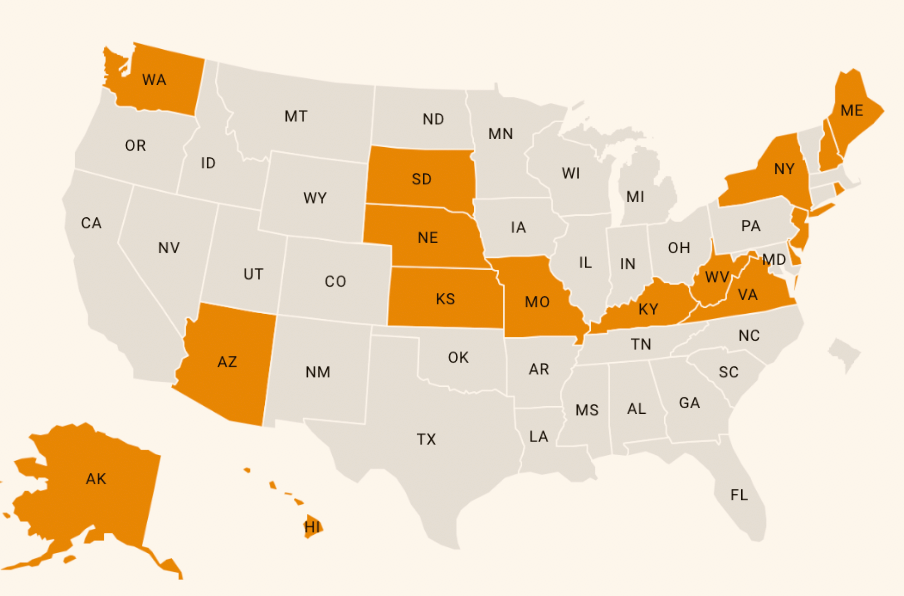Governors use their annual state-of-the-state addresses to showcase successes and accomplishments over the past year and to define their policy priorities for the year ahead. This year 36 states will hold gubernatorial elections, so many governors use their state-of-the-state addresses to build their case for reelection and visions for the future. By late February, 41 governors had delivered speeches outlining plans to address a wide variety of health and economic related issues in the coming year, as the immediate health-related emergency of the COVID-19 pandemic has faded. Most governors reflected on the incredible response from frontline responders and public health agencies’ ability to meet the needs of the crisis but focused their future plans on how to emerge from the pandemic and respond to the economic and mental health crises that remain.
Priorities diverged from their 2021 health care and social determinants priorities. While many governors continued to address social drivers of health, citing affordable housing and access to healthy food and the environment as key levers to improve health, more highlighted livable wages, support for the workforce and business, and education. Notably, in comparison to last year, many more governors highlighted the need to address health care workforce shortages that have been exacerbated by the COVID-19 crisis. Governors also mentioned their priorities for investing American Rescue Plan Act (ARPA) funding.
These issues do not exist in isolation; many of these topics, including mental health, education, workforce, and equity, are woven throughout the speeches and require a whole-of-government approach to address. Below are highlights from key themes that the governors addressed.

Twenty-eight governors discussed behavioral health in their speeches this year, up from 22 last year. With an increased focus on crisis services, substance use disorder services and school-based mental health care as a result of COVID-19, governors addressed the need for investments in behavioral health services and workforce.
Fourteen governors mentioned making significant investments in behavioral health in their state-of-the- state addresses. In Idaho, Gov. Little proposed accelerating the implementation of the Behavioral Health Council’s recommendations, including a $50 million dollar investment in behavioral health care. In the executive budget, Gov. Lujan Grisham of New Mexico is proposing “tens of millions of dollars into new behavioral health services, expanding access to treatment for substance abuse, suicide interventions and more. New Mexicans call me about this issue more than almost any other, and we will answer that call.”
Ten governors mentioned substance use disorder, including the opioid epidemic and recent rises in overdoses over the past year. New Jersey Gov. Murphy discussed the state’s data driven approach to the opioid-use epidemic and expansion of harm reduction centers and naloxone.
In Delaware and Tennessee, governors discussed their executive branch efforts to combat the opioid epidemic. In Delaware, the Behavioral Health Consortium is led by Lt. Gov. Hall-Long, and the state was one of a few to see a decrease in the rate of overdose deaths. In Tennessee, Attorney General Slatery is working to deploy funding from the $26 billion dollar suit against pharmaceutical companies. Governors in Alaska and Missouri discussed providing behavioral health services to individuals in the criminal justice system.
Nine governors referenced youth behavioral health and school-based services now that children are back in the classroom. In Alabama, Michigan, Vermont, Washington, and Wisconsin, governors proposed additional school mental health supports. Gov. McMaster in South Carolina stated, “we must also recognize that a mental health crisis exists in South Carolina, especially among our young people who have weathered two years of disruptions, virtual instruction, isolation, and constant changes to normal routines.” He also directed the Health and Human Services Director to study the state’s behavioral health system as 60 percent of South Carolina children are enrolled in Medicaid. In Washington, Gov. Inslee’s budget will increase the number of school counselors, nurses, psychologists, and social workers in schools.
Six governors discussed strengthening the crisis system of care in their states through outreach services, mobile unitsand new centers. Gov. Ivey of Alabama proposed funding for two new mental health crisis centers and in New Hampshire, Gov. Sununu discussed mobile crisis support and a new 24/7 crisis call center. Alaska Gov. Dunleavy announced reopening the unit that serves adolescents in crisis, and additional funding for staffed beds.
Six governors also discussed supporting the behavioral health workforce through crosscutting investments. Massachusetts Gov. Baker discussed working with the legislature to address “enormous staff and clinician shortages in exactly the areas of care that we need most.” In Michigan, Gov. Whitmer stated, “40 percent of Michiganders do not get treatment for their mental illness. We will address this shortfall by expanding Michigan’s Loan Repayment Program for mental health professionals. And we will make a historic investment to retain and recruit hundreds more mental health workers.”
This year, 17 governors discussed broadband in their state-of-the-state speeches, down from 30 in 2021. Governors in four states, Alabama, Delaware, Hawai’i and Maine proposed leveraging ARPA funding to support broadband efforts in their states. Other themes included broadband connectivity to support remote work and education and the creation of statewide authorities for broadband. Missouri Gov. Parson requested a “$34 million dollar investment in rural communities to increase access to telehealth and telemedicine services.”
Five governors identified broadband as critical for supporting remote work and education. According to Kansas Gov. Kelly, hotspots were deployed to students in low-income households to continue their education remotely. Gov. Dunleavy in Alaska stated that broadband “…unlocks the opportunity for us to live anywhere and work from anywhere in this Great State.”
Additionally, governors in Kansas and Maine are establishing statewide broadband authorities, In Kansas, the Office of Broadband Development has expanded internet access to over 50,000 new households and businesses. The MaineConnectivity Authority is “a new entity charged with achieving universal internet access.”
In 2021, 34 governors addressed COVID-19 in their state-of-the-state speeches, emphasizing vaccine distribution and economic recovery. In 2022, 17 governors mentioned COVID-19 with a focus on COVID-19 mandates, return to school, testing and vaccines.
The continued rollout of vaccines and testing as a strategy to mitigate the spread of COVID-19 were discussed by 12 governors. Gov. Sununu in New Hampshire emphasized the importance of data guiding the state’s approach. In South Dakota, Gov. Noem mentioned the state’s free at-home test program and announced an additional 1 million new tests to be delivered throughout the state.
Four governors spoke against COVID-19 mandates, including vaccines and masking. Gov. Dunleavy of Alaskastated his administration, “will continue to defend Alaskans’ rights to make their own medical decisions about vaccines and therapeutics for themselves and their families in consultation with their doctors and pharmacists.” Similarly, Gov. Parson of Missouri said, “when it comes to COVID-19 mandates, I firmly believe that the people should have say through their local elected representatives and not be dictated by needless executive action or any one person.”
Return to in-person instruction and masks in schools were discussed by three governors. Recently elected Gov. Youngkinof Virginia signed an executive order that allows parents to opt out of mask mandates in schools. In Kentucky, Gov. Beshear discussed the strategy to prioritize vaccines for educators and the state’s ability to return to in-person instruction in every school district early on.
Thirty-seven governors discussed education this year and the impacts of COVID-19 were present throughout the speeches. Major themes included teacher recruitment and retention, addressing learning loss, and affordability of higher education. There was a marked decrease compared to last year in the number of governors that talked about expanding access to early education. Twenty-three governors proposed generalized investment in schools and students, and five governors emphasized the importance of keeping children in the classroom. Gov. Ige of Hawai’iemphasized the importance of in-person learning, but also announced the launch of the Hawai’i Virtual Learning Network—a virtual classroom network that can supplement in-person classes.
Eighteen governors talked about recruiting and retaining qualified teachers, with a major focus on increasing teacher salaries and recognizing the difficulties that educators have faced over the past two years. Gov. DeSantis of Florida proposed increases in teacher salaries in addition to $1000 bonuses for the second year in a row. Some governors also mentioned other types of support for teachers. For example, Gov. Hochul of New York proposed more “effective training and support, faster and easier certification, and stronger career pipelines and ladders”.
Sixteen governors proposed targeted investments in improving the quality of education in their states by enhancing literacy levels and meeting benchmarks, supporting greater investment in STEM education, or by making up learning loss sustained during the COVID-19 pandemic. Gov. Burgum of North Dakota talked about setting computer science and cyber science graduation standards for K-12 students, undergraduate students, and graduate students. Indiana Gov. Holcomb talked about the continued investment in accelerated learning programs to support students who fell behind during the pandemic.
Many governors also focused on opportunities following K-12 education, whether entering the workforce, enrolling at a community college, or attending a four-year university. Ten governors talked about apprenticeship programs and adult education opportunities, fourteen proposed investments in higher education, with nine of those focusing specifically on community college investments, and sixteen governors proposed higher education affordability measures like tuition freezes, scholarships, or loan forgiveness programs.
Ten governors also emphasized parental choices and roles in education, through vouchers, school choice programs, charter schools, or more parental involvement in curriculum. Idaho Gov. Little proposed an investment in Empowering Parents grants, which would cover “computers, tutoring, internet connectivity and other needs so students have the best chance for success.”
COVID-19 clearly shone a light on racial and ethnic health and economic-related disparities that existed prior to the pandemic, and in 2022, 9 governors highlighted the connection to equity in their plans, down from 21 governors in 2021. Three governors discussed the connection and disproportionate impact of the environment on low-income communities and communities of color. Oregon Gov. Brown used an equity lens to set the tone of her speech. She noted that she is “…most proud of is how Oregon approaches … challenges––through an equity lens. With a focus on our communities hardest hit by climate change: rural communities, people with low incomes, and people of color.”
Delaware Gov. Carney announced that the state, with federal support, will invest more than $400 million in Delaware’s clean water infrastructure, focusing on underserved communities. New York’s Gov. Hochul also proposed work to fix longstanding problems that disproportionately impact communities of color, including reconnecting neighborhoods that were cut off by highways, and directing the Metropolitan Transit Authority (MTA) to conduct an environmental review, to ensure no further harm is done.
Three governors also considered the intersection of poverty and communities of color and developed strategies to mitigate economic impacts.
Seven governors addressed increasing health care costs— emphasizing the need to alleviate the burden of rising healthcare costs on both individuals and state budgets. Notable state efforts to lower costs across the health care system include:
- New Jersey Gov. Murphy committed to lowering healthcare and prescription drug costs through a cost growth benchmark and additional transparency requirements throughout the prescription drug supply chain to identify cost drivers.
- Nevada Gov. Sisolak announced that the state will join the Northwest Prescription Drug Consortium with Washington and Oregon to leverage collective purchasing power to lower the cost of prescription drugs.
- Gov. Cox of Utah asked legislators to support the newly established Utah Sustainable Health Collaborative tasked with developing strategies to lower health care costs while improving outcomes.
- Virginia Gov. Youngkin expressed support for legislation to extend access to association health plans, providing small business owners with a lower cost coverage option for their employees. Three governors celebrated successful state reforms which have lowered health insurance costs in the individual and small group market.
- Colorado Gov. Polis shared that the state reinsurance program reduced healthcare premiums by 24 percent on the individual market, with even more significant cost savings in the western region of the state.
- Following last year’s launch of a state-based marketplace, New Jersey Gov. Murphy shared that enrollment in the individual marketplace increased by more than 25 percent.
- Nevada Gov. Sisolak touted last year’s adoption of a public option to increase affordability and expand coverage options.
Five governors addressed the issue of rising prescription drug costs, with the majority focusing on the prohibitively high cost of insulin. Governors in Michigan and Colorado aim to improve insulin affordability through monthly price caps and Gov. Whitmer of Michigan announced that the state’s Attorney General would launch an investigation into one of the largest producers of insulin for excessive pricing.
This year, against the backdrop of ongoing COVID-19 hospitalizations and concerns about burnout, 20 governors talked about their plans to address workforce shortages and bolster the health care workforce. In 2021, only eight governors mentioned plans to support or bolster the healthcare workforce. Recruitment was the overarching theme this year, with fifteen governors talking about how to successfully train more nurses, doctors, or emergency responders, how to use scholarships or loan forgiveness programs to incentivize entry into the health care field, and how to bring more health care providers into the state from elsewhere. Governors of New York, South Dakota, and Vermont talked about recognizing out of state licenses to attract qualified providers to their states. In Alaska, Georgia, Hawai’i, Maine, New Mexico, and Oklahoma, governors talked about expanding education programs to train more nurses and other health care providers. These proposals included plans for adding faculty to existing programs, opening new educational programs, and admitting more students to increase the number of graduates. Gov. Reynolds of Iowa announced a new apprenticeship program for high school students that would allow them to become certified nursing assistants before graduating high school. And governors in Iowa, Illinois, Rhode Island,and New York mentioned plans to offer additional scholarships, tuition reimbursement, or loan forgiveness for students training to enter the health care workforce—particularly if they stay in-state after graduating.
In addition to recruitment, nine governors also focused on strategies to retain the existing workforce—particularly those individuals who are experiencing the exhaustion of the COVID-19 pandemic. In Alabama, Colorado, Maine, New York, and Wisconsin, governors talked about increased compensation for those in the healthcare field, through pay raises, higher Medicaid reimbursement rates, or bonuses. Gov. Polis of Colorado and Gov. Pritzker of Illinoismentioned plans to wave licensing fees for healthcare providers in their states.
Sixteen governors addressed housing and homelessness in their state of the state speeches. Highlighting the impact of the COVID-19 pandemic, governors concentrated on the need to increase the supply of affordable housing, strategies to reduce homelessness, and rent and mortgage assistance. In her speech, Gov. Brown in Oregon made the connection between housing and homelessness stating, “there is no avoiding the fact that these two issues are undeniably linked –– a lack of affordable housing and some of the highest rates of people experiencing homelessness. In Oregon, today, missing one paycheck can be the difference between going to bed in a home with heat and running water, or sleeping unsheltered.”
Eleven governors spoke for the need to increase the housing stock with an emphasis on affordable housing. Gov. Mills of Maine referenced the Maine Jobs and Recovery Plan which will invest $50 million to “increase the number of energy-efficient, affordable homes for working Maine people.” In Colorado, Gov. Polis announced 14,000 units of affordable housing have been developed in the past year, saving families more than $72 million annually.
Governors in Delaware, New Mexico and Oregon discussed providing rent and mortgage assistance to residents, and governors in Colorado, Delaware and New Hampshire addressed using ARPA funding to support their housing programs. New Mexico Gov. Lujan Grisham said, “in the next 12 months your state government is going to deliver an additional $230 million in rent and utility assistance to the New Mexicans who need it most.”
In addition to increasing the housing supply, five governors discussed reducing homelessness in their states, proposing models such as permanent supportive housing. In Colorado, Gov. Polis proposed several interventions to address homelessness including “affordable and transitional housing, substance use treatment and recovery care, related residential programs, and permanent housing with wrap-around support services, and recipients of funds need to be held accountable for actually reducing homelessness.” Gov. Hochul of New York identified root causes of homelessness in her speech—poverty, addiction and housing insecurity—and announced a five-year housing plan to preserve 100,000 affordable homes with supportive services in 10,000 units.
The topic of employment, workforce investments, livable wages and the need to support overall economic growth was mentioned by a total of 38 governors, which is an increase from last year when 28 governors focused on this topic.
The most common theme was planned investments to promote workforce development through new training initiatives. Governors in Maine, Oklahoma, South Carolina, Tennessee and Vermont specifically mentioned apprenticeship opportunities and career development for adolescents and young adults, and Vermont’s Gov. Scott placed an emphasis on trades training, in particular to help grow the number of nurses and other healthcare workers in the state. Oregon’s Gov. Brown discussed plans to build upon Future Ready Oregon, a workforce training initiative focused on jobs in health care, technology, manufacturing, and construction. She also mentioned plans to incorporate support services to help individuals advance from an entry-level job such as a certified nursing assistant to a health care administrator. Governors in Delaware, Michigan, Mississippi, and South Carolina shared plans to invest recently allocated federal funds to support workforce skills training initiatives, and Hawai’i’s Gov. Ige highlighted the launch of an online hub designed to connect unemployed individuals with career and training opportunities.
Governors also focused on the issue of supporting overall economic development. Delaware’s governor highlighted the state’s focus on championing small businesses to bolster job growth, including both “mom-and-pop” small businesses as well as cutting-edge technology companies, and Gov. Murphy of New Jersey commented similarly about supporting both technology start-ups and traditional small businesses. Other governors spoke about the role of planned tax cuts with the intention of supporting job creation, with governors in Colorado, Idaho, and Indiana mentioning this issue.
Some governors also focused on the issue of wages and highlighted plans to increase pay rates for state employees, such as law enforcement and teachers. The governors of Alabama, Kentucky and Missouri announced pay raises for all state workers, and Gov. McMaster commented that while overall compensation for South Carolina state employees should be reevaluated, salary increases should be determined by merit-based performance incentives rather than an across-the-board pay raise. Proposals to increase salaries for teachers specifically were raised by the governors in Alabama, Florida, Georgia, Mississippi, Oklahoma, South Carolina, and Tennessee. Additionally, the governors of both Delaware and Pennsylvania advocated for an increase in the overall minimum wage in their states. Gov. Wolf noted that when factoring in inflation, minimum wage workers in Pennsylvania actually experienced a $2 pay reduction.
Despite the significant growth in state Medicaid programs during the pandemic, only five governors mentioned Medicaid in their speeches.
Several governors proposed Medicaid coverage and benefit expansions. In response to rising maternal mortality rates, governors in Georgia and Rhode Island advocated for extending postpartum Medicaid coverage from 60 days to 12 months to provide coverage continuity during the critical postpartum period. Rhode Island Gov. McKeeintroduced a proposal to cover all kids regardless of immigration status through the state’s Medicaid program. Tennessee Gov. Leeannounced a $25 million dollar investment to broaden access to dental services for over 600,000 Medicaid recipients as well as an additional $55 million to support the Medicaid Pathways to Independence program.
Only Kansas Gov. Kelly advocated for adoption of Medicaid expansion, providing the economic argument that, “Medicaid expansion won’t just protect small towns and their residents, it will keep health care professionals from moving to neighboring states… (without Medicaid expansion) we are sabotaging our rural communities and their efforts to recruit new jobs and residents”.
The broader topic of health coverage and access was mentioned by governors in six states — a significant decline from last year when 17 governors addressed these issues. Governors were largely focused on the need to improve rural health care access:
- New Mexico Gov. Lujan Grisham proposed the creation of a Rural Health Care Delivery Fund to provide support for health systems in counties with fewer than 100,000 residents. The fund would provide financial support for newly constructed hospitals in rural areas to compensate for operating losses incurred during the first five years of operation.
- South Dakota Gov. Noem aims to improve health care options for rural communities by extending telehealth flexibilities to emergency responders.
- Wyoming Gov. Gordon committed to improving care accessibility through improvements to the state’s Emergency Medical System.
- Gov. Evers of Wisconsin will invest $20 million to provide rural communities with flexible funding to increase staffing support and provide additional training to first responders.
- Gov. Pritzker of Illinois commented on the state’s recent $3.8 billion dollar investment in hospitals serving high proportions of Medicaid patients to improve care in underserved communities.
Below is a snapshot of some of the other health-related topics that governors mentioned:
Aging
Four governors mentioned issues related to the elderly population in their speeches. Mills of Maine announced plans to establish a Silver Cabinet (similar to the state’s Children’s Cabinet) to promote interagency action on long-term care issues. New Mexico’s governor proposed an initiative called New Mexi-Care to expand an existing state program that supports and reimburses caregivers for the care they provide to elderly family members, regardless of Medicaid eligibility. Also, although New York’s Gov. Hochul did not mention the topic of aging in her speech, in an accompanying document she outlined intentions to develop a state master plan for aging.
Child Care and Family Supports
Nine governors commented on proposals to support the needs of families, such as Delaware’s Gov. Carney advocating for paid leave in the private sector as well as other governors promoting increased access to high-quality and affordable child care. Maine’s Gov. Mills noted plans to include $12 million in the state’s supplemental budget to increase child care workers’ wages, and also highlighted the use of American Rescue Plan Act funds to strengthen the state’s child care system, which includes stipends for child care workers as well as investments in child care facilities and early childhood education programs. Iowa’s Gov. Reynolds announced an expansion of the state’s Childcare Challenge, which is designed to increase access to child care options for families, and commented on progress in implementing recommendations from the state’s Child Care Task Force. North Dakota’s Gov. Burgum highlighted a new initiative that will be launched in the spring to help employers offer child care benefits to their employees and a soon-to-be finalized comprehensive state strategy for increasing access to high-quality, affordable child care. Utah’s Gov. Cox proposed creating a new government position to address the needs of parents and children, which will focus on parental leave, increased access to child care, and mentoring opportunities for parents. Also, Tennessee’s Gov. Lee highlighted recent funding for the state’s Healthy Starts Initiative, which focuses on maternal health and holistic care for both mothers and children.
Child Welfare
Eight governors spoke about the child welfare system, including the governors of Arizona, Florida, Georgia, and Tennessee who mentioned potential new investments to support caregivers. Ducey in Arizona mentioned plans to provide resources to extended family members caring for children who would otherwise be in the foster care system, and Georgia’s governor proposed a 10 percent provider rate increase for all foster parents, relative caregivers, and child caring and placing agencies. In Washington, Gov. Inslee said that his budget would include $80 million to support foster care youth with complex needs and help them transition out of foster care. Gov. Kelly noted that Kansas was one of the first states to implement the Family First Prevention Services Act and the recent creation of the Division of the Child Advocate to help ensure that youth in the child welfare system are healthier and safer.
Environmental Actions
Seventeen governors discussed their plans to protect the environment, including plans to address climate resiliency and ensuring clean air and water for residents. Ten governors discussed plans to improve water quality. Kansas shared the state’s new water plan, a five-year blueprint to ensure the state has a reliable, quality water supply to support the needs of Kansas communities, including their farming economy. Ten governors discussed their plans to address climate change and promote climate resiliency. Delaware’ Gov. Carney announced the state’s new Climate Action Plan. Six governors discussed actions to reduce carbon emissions or become carbon neutral, and four governors noted deadlines by which this must occur. Ige reflected that Hawai’i was the first state to commit to a net-negative goal by 2045 and re-committed to doubling down on this effort.
Food Access
Eight governors commented on the issue of food security, distribution, and production. Alaska’s Gov. Dunleavy spoke about plans to create a Food Security Task Force to help promote the state’s agriculture and mariculture industries and minimize disruptions in the food supply chain by supporting state-grown products. In response to rising food costs, governors in both Illinois and Kansas advocated that their state’s grocery taxes should be suspended, and Utah’s governor proposed a $160 million grocery tax credit for families. Maine’s Gov. Mills announced that her proposed budget will include plans to fund universal free meals in schools and promote school and community gardens.
Public Health
Three governors addressed the topic of public health, with the governor of Indiana mentioning a number of public health issues, including that the state’s Public Health Commission will be publishing recommendations on ways to modernize and strengthen the state’s overall public health system. Also, given that the state ranks 46th in obesity, 46th in smoking, and 40th in childhood immunizations, he emphasized the importance of investing in preventive measures to minimize future costly health complications. Additionally, he noted plans to continue focusing on reducing infant mortality and strengthening childhood lead screening efforts. Nebraska’s Gov. Ricketts highlighted plans to use $200 million from the American Rescue Plan Act for public health emergency response efforts. South Carolina’s governor also noted plans to use federal funds for investments in upgrading water and sewer systems and commented on how these enhancements can improve the overall public health of communities.
Transportation
Seven governors spoke about transportation infrastructure investments from a health-focused perspective. Five governors mentioned initiatives to support clean transportation, with Delaware’s Gov. Carney and Michigan’s Gov. Whitmer highlighting plans to dedicate resources to support electric vehicles and Washington’s Gov. Inslee proposing to invest nearly $1 billion to fund a range of transportation programs that reduce pollution. Additionally, Indiana’s Gov. Holcomb spoke about investing in commuter rail projects as well as committing $150 million to expand the state’s walking, hiking, and biking trails.
Violence Prevention
Thirteen governors commented on the issue of violence prevention. The governors of Delaware, Maryland, New Jersey, and New York emphasized the importance of gun violence prevention, and the governors of both Colorado and Illinois focused on community-based violence prevention initiatives. Alaska’s Gov. Dunleavy requested state legislators to fund the People First Initiative, which includes addressing the issues of domestic violence and sexual assault, human trafficking, and missing and murdered Indigenous individuals.
Conclusion
As the United States enters the third year of the pandemic, governors’ 2022 state-of-the-state speeches reflect the realities of health and economic recovery. Compared to 2021, states have access to additional resources through ARPA, and their priorities remain centered on addressing the lasting impacts of the COVID-19 pandemic with an emphasis on behavioral health, education and jobs and wages. As state legislatures convene and enact budgets, the National Academy for State Health Policy will continue to track many of these topics in the coming months.




